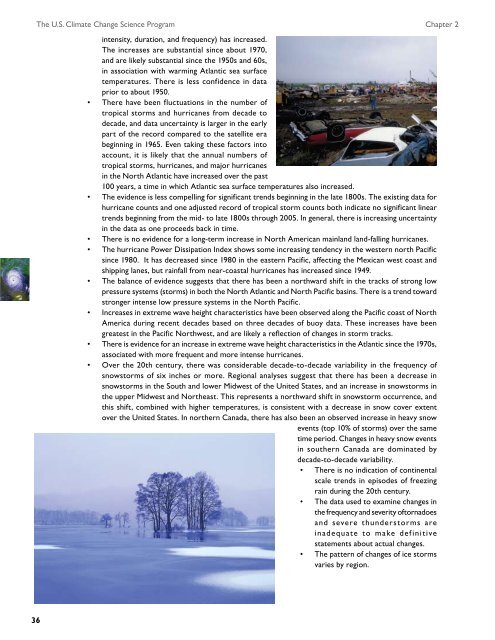Weather and Climate Extremes in a Changing Climate. Regions of ...
Weather and Climate Extremes in a Changing Climate. Regions of ...
Weather and Climate Extremes in a Changing Climate. Regions of ...
Create successful ePaper yourself
Turn your PDF publications into a flip-book with our unique Google optimized e-Paper software.
The U.S. <strong>Climate</strong> Change Science Program Chapter 2<br />
36<br />
•<br />
•<br />
•<br />
•<br />
•<br />
•<br />
•<br />
•<br />
<strong>in</strong>tensity, duration, <strong>and</strong> frequency) has <strong>in</strong>creased.<br />
The <strong>in</strong>creases are substantial s<strong>in</strong>ce about 1970,<br />
<strong>and</strong> are likely substantial s<strong>in</strong>ce the 1950s <strong>and</strong> 60s,<br />
<strong>in</strong> association with warm<strong>in</strong>g Atlantic sea surface<br />
temperatures. There is less confidence <strong>in</strong> data<br />
prior to about 1950.<br />
There have been fluctuations <strong>in</strong> the number <strong>of</strong><br />
tropical storms <strong>and</strong> hurricanes from decade to<br />
decade, <strong>and</strong> data uncerta<strong>in</strong>ty is larger <strong>in</strong> the early<br />
part <strong>of</strong> the record compared to the satellite era<br />
beg<strong>in</strong>n<strong>in</strong>g <strong>in</strong> 1965. Even tak<strong>in</strong>g these factors <strong>in</strong>to<br />
account, it is likely that the annual numbers <strong>of</strong><br />
tropical storms, hurricanes, <strong>and</strong> major hurricanes<br />
<strong>in</strong> the North Atlantic have <strong>in</strong>creased over the past<br />
100 years, a time <strong>in</strong> which Atlantic sea surface temperatures also <strong>in</strong>creased.<br />
The evidence is less compell<strong>in</strong>g for significant trends beg<strong>in</strong>n<strong>in</strong>g <strong>in</strong> the late 1800s. The exist<strong>in</strong>g data for<br />
hurricane counts <strong>and</strong> one adjusted record <strong>of</strong> tropical storm counts both <strong>in</strong>dicate no significant l<strong>in</strong>ear<br />
trends beg<strong>in</strong>n<strong>in</strong>g from the mid- to late 1800s through 2005. In general, there is <strong>in</strong>creas<strong>in</strong>g uncerta<strong>in</strong>ty<br />
<strong>in</strong> the data as one proceeds back <strong>in</strong> time.<br />
There is no evidence for a long-term <strong>in</strong>crease <strong>in</strong> North American ma<strong>in</strong>l<strong>and</strong> l<strong>and</strong>-fall<strong>in</strong>g hurricanes.<br />
The hurricane Power Dissipation Index shows some <strong>in</strong>creas<strong>in</strong>g tendency <strong>in</strong> the western north Pacific<br />
s<strong>in</strong>ce 1980. It has decreased s<strong>in</strong>ce 1980 <strong>in</strong> the eastern Pacific, affect<strong>in</strong>g the Mexican west coast <strong>and</strong><br />
shipp<strong>in</strong>g lanes, but ra<strong>in</strong>fall from near-coastal hurricanes has <strong>in</strong>creased s<strong>in</strong>ce 1949.<br />
The balance <strong>of</strong> evidence suggests that there has been a northward shift <strong>in</strong> the tracks <strong>of</strong> strong low<br />
pressure systems (storms) <strong>in</strong> both the North Atlantic <strong>and</strong> North Pacific bas<strong>in</strong>s. There is a trend toward<br />
stronger <strong>in</strong>tense low pressure systems <strong>in</strong> the North Pacific.<br />
Increases <strong>in</strong> extreme wave height characteristics have been observed along the Pacific coast <strong>of</strong> North<br />
America dur<strong>in</strong>g recent decades based on three decades <strong>of</strong> buoy data. These <strong>in</strong>creases have been<br />
greatest <strong>in</strong> the Pacific Northwest, <strong>and</strong> are likely a reflection <strong>of</strong> changes <strong>in</strong> storm tracks.<br />
There is evidence for an <strong>in</strong>crease <strong>in</strong> extreme wave height characteristics <strong>in</strong> the Atlantic s<strong>in</strong>ce the 1970s,<br />
associated with more frequent <strong>and</strong> more <strong>in</strong>tense hurricanes.<br />
Over the 20th century, there was considerable decade-to-decade variability <strong>in</strong> the frequency <strong>of</strong><br />
snowstorms <strong>of</strong> six <strong>in</strong>ches or more. Regional analyses suggest that there has been a decrease <strong>in</strong><br />
snowstorms <strong>in</strong> the South <strong>and</strong> lower Midwest <strong>of</strong> the United States, <strong>and</strong> an <strong>in</strong>crease <strong>in</strong> snowstorms <strong>in</strong><br />
the upper Midwest <strong>and</strong> Northeast. This represents a northward shift <strong>in</strong> snowstorm occurrence, <strong>and</strong><br />
this shift, comb<strong>in</strong>ed with higher temperatures, is consistent with a decrease <strong>in</strong> snow cover extent<br />
over the United States. In northern Canada, there has also been an observed <strong>in</strong>crease <strong>in</strong> heavy snow<br />
events (top 10% <strong>of</strong> storms) over the same<br />
time period. Changes <strong>in</strong> heavy snow events<br />
<strong>in</strong> southern Canada are dom<strong>in</strong>ated by<br />
decade-to-decade variability.<br />
• There is no <strong>in</strong>dication <strong>of</strong> cont<strong>in</strong>ental<br />
scale trends <strong>in</strong> episodes <strong>of</strong> freez<strong>in</strong>g<br />
ra<strong>in</strong> dur<strong>in</strong>g the 20th century.<br />
• The data used to exam<strong>in</strong>e changes <strong>in</strong><br />
the frequency <strong>and</strong> severity <strong>of</strong>tornadoes<br />
<strong>and</strong> severe thunderstorms are<br />
<strong>in</strong>adequate to make def <strong>in</strong>itive<br />
statements about actual changes.<br />
• The pattern <strong>of</strong> changes <strong>of</strong> ice storms<br />
varies by region.




